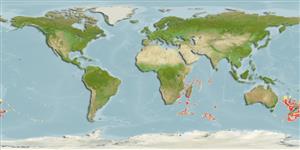Elasmobranchii (Haie und Rochen) (sharks and rays) >
Carcharhiniformes (Ground sharks) >
Pentanchidae (Deepwater catsharks)
Etymology: Parmaturus: parma (L.), from parme (Gr.), small shield; oura (Gr.), tail, presumably referring to upper edge of caudal fin “armed with modified” scales (per Garman 1913). (See ETYFish); macmillani: In honor of ichthyologist Peter McMillan (b. 1955, note Latinization of “Mc” to “Mac”), who collected type and “many examples of undescribed or poorly known marine fish and invertebrate species” from deep waters off New Zealand. (See ETYFish).
Environment: milieu / climate zone / depth range / distribution range
Ökologie
seewasser bathydemersal; tiefenbereich 670 - 1500 m (Ref. 26346). Deep-water
Southwest in the Indian Ocea, Madagascar and the Pacific, New Zealand.
Size / Gewicht / Alter
Maturity: Lm ? range ? - ? cm
Max length : 45.0 cm TL Männchen/unbestimmt; (Ref. 26346)
A rare and poorly known species inhabiting the lower continental slope (Ref. 26346).
Life cycle and mating behavior
Geschlechtsreife | Fortpflanzung | Ablaichen | Eier | Fecundity | Larven
Cox, G. and M. Francis, 1997. Sharks and rays of New Zealand. Canterbury Univ. Press, Univ. of Canterbury. 68 p. (Ref. 26346)
IUCN Rote Liste Status (Ref. 130435)
Bedrohung für Menschen
Harmless
Nutzung durch Menschen
Mehr Information
NamenSynonymeMetabolismusRäuberÖkotoxikologieFortpflanzungGeschlechtsreifeAblaichenSpawning aggregationFecundityEierEientwicklung
Alter/Größe
Wachstum
Länge-Gewicht
Länge-Länge
Längenhäufigkeiten
Morphometrie
Morphologie
Larven
Larven Pop.Dyn.
Rekrutierung
Dichte
BRUVS
ReferenzenAquakulturAquakultur ProfilZuchtlinienGenetikElectrophoresesVererbbarkeitKrankheitenVerarbeitungNutrientsMass conversion
PartnerBilderStamps, Coins Misc.LauteCiguateraGeschwindigkeitSchwimmstilKiemenoberflächeOtolithsGehirngrößeSehfähigkeit
Tools
Zusatzinformationen
Download XML
Internet Quellen
Estimates based on models
Preferred temperature (Ref.
123201): 2.2 - 7.3, mean 5.8 °C (based on 161 cells).
Phylogenetic diversity index (Ref.
82804): PD
50 = 0.5010 [Uniqueness, from 0.5 = low to 2.0 = high].
Bayesian length-weight: a=0.00355 (0.00176 - 0.00714), b=3.09 (2.91 - 3.27), in cm total length, based on LWR estimates for this (Sub)family-body shape (Ref.
93245).
Trophic level (Ref.
69278): 4.0 ±0.6 se; based on size and trophs of closest relatives
Widerstandsfähigkeit (Ref.
120179): niedrig, Verdopplung der Population dauert 4,5 - 14 Jahre. (Fec assumed to be <100).
Fishing Vulnerability (Ref.
59153): Low to moderate vulnerability (35 of 100).
